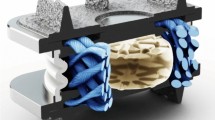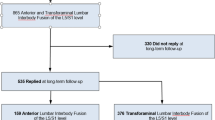Abstract
Aim
To correlate clinical and radiological outcome following one- and two-level anterior cervical discectomy and fusion (ACDF) with stand-alone polyetheretherketone (PEEK) cages filled with demineralized bone matrix (DBM).
Methods
We performed a retrospective review of a consecutive patient cohort with degenerative disc disease that underwent ACDF with stand-alone PEEK cages filled with demineralized bone matrix (DBM) between 2010 and 2013 with a minimum follow-up of 12 months. Changes in the operated segments were measured and compared to radiographs directly after surgery. Clinical outcome was evaluated by a physical examination, pain by visual analog scale (VAS) for arm and neck. Health-related quality of life was measured using the EuroQOL questionnaire (EQ-5D).
Results
Of 282 consecutive cases, follow-up data were obtained from 194 (69%) cases. The median age at presentation was 54 years and 91 patients were male (46%). Ninety-eight and 96 patients had one- and two-level surgeries, respectively. Mean VAS pain was reduced from 5.2 ± 3.6 to 2.6 ± 2.4 (p < 0.001) and from 5.8 ± 3.3 to 2.1 ± 2.7 (p < 0.001) in the myelopathy and radiculopathy group, respectively. Fusion was achieved in 79 and 82% of segments in one- and two-level surgeries, respectively. Cervical alignment was better in 10 and 1%, similar in 68 and 76%, worse in 23 and 23% in one- and two-level surgeries, respectively. Subsidence was observed in 44 and 34% of segments in one- and two-level surgeries, respectively. Follow-up operations due to symptomatic adjacent disc disease or implant failure were needed in 13 (7%) and 15 (8%) of cases, respectively. Subsidence, adjacent disc disease, and cervical alignment all had no influence on the clinical outcome.
Conclusions
The clinical outcome after ACDF with PEEK cages filled with demineralized bone matrix is highly satisfactory. Radiological signs of non-fusion, subsidence, and cervical alignment have no influence on clinical outcome.







Similar content being viewed by others
References
Barsa P, Suchomel P (2007) Factors affecting sagittal malalignment due to cage subsidence in standalone cage assisted anterior cervical fusion. Eur Spine J 16:1395–1400
Cabraja M, Oezdemir S, Koeppen D, Kroppenstedt S (2012) Anterior cervical discectomy and fusion: comparison of titanium and polyetheretherketone cages. BMC Musculoskelet Disord 13:172
Chagas H, Domingues F, Aversa A, Vidal Fonseca AL, de Souza JM (2005) Cervical spondylotic myelopathy: 10 years of prospective outcome analysis of anterior decompression and fusion. Surg Neurol 64:30–35
Demircan MN, Kutlay AM, Colak A, Kaya S, Tekin T, Kibici K, Ungoren K (2007) Multilevel cervical fusion without plates, screws or autogenous iliac crest bone graft. J Clin Neurosci 14:723–728
Dufour T, Huppert J, Louis C, Beaurain J, Stecken J, Aubourg L, Vila T (2010) Radiological analysis of 37 segments in cervical spine implanted with a peek stand-alone device, with at least one-year follow-up. Br J Neurosurg 24:633–640
Ebersold MJ, Pare MC, Quast LM (1995) Surgical treatment for cervical spondylotic myelopathy. J Neurosurg 82:745–751
Emery E, Bohlman H, Bolesta MJ, Jones P (1998) Anterior cervical decompression and arthrodesis for the treatment of cervical spondylotic myelopathy. Two to seventeen-year follow-up. J Bone Joint Surg Am 80:941–951
Fallah A, Akl EA, Ebrahim S, Ibrahim GM, Mansouri A, Foote CJ, Zhang Y, Fehlings MG (2012) Anterior cervical discectomy with arthroplasty versus arthrodesis for single-level cervical spondylosis: a systematic review and meta-analysis. PLoS One 7:e43407
Fischer CR, Cassilly R, Cantor W, Edusei E, Hammouri Q, Errico T (2013) A systematic review of comparative studies on bone graft alternatives for common spine fusion procedures. Eur Spine J 22:1423–1435
Fujiwara K, Yonenobu K, Ebara S, Yamashita K, Ono K (1989) The prognosis of surgery for cervical compression myelopathy. An analysis of the factors involved. J Bone Joint Surg Br 71:393–398
Gore DR, Sepic SB, Gardner GM (1986) Roentgenographic findings of the cervical spine in asymptomatic people. Spine (Phila Pa1976) 11:521–524
Hu Y, Lv G, Ren S, Johansen D (2016) Mid- to long-term outcomes of cervical disc arthroplasty versus anterior cervical discectomy and fusion for treatment of symptomatic cervical disc disease: a systematic review and meta-analysis of eight prospective randomized controlled trials. PLoS One 11:e0149312
Jacobs W, Willems PC, Kruyt M, van Limbeek J, Anderson PG, Pavlov P, Bartels R, Oner C (2011) Systematic review of anterior interbody fusion techniques for single- and double-level cervical degenerative disc disease. Spine (Phila Pa 1976) 36:E950–E960
Kaiser MG, Mummaneni PV, Matz PG, Anderson PA, Groff MW, Heary RF, Holly LT, Ryken TC, Choudhri TF, Vresilovic EJ, Resnick DK (2009) Joint section on disorders of the spine and peripheral nerves of the American Association of Neurological Surgeons and Congress of Neurological Surgeons Radiographic assessment of cervical subaxial fusion. J Neurosurg Spine 11:221–227
Katsuura A, Hukuda S, Saruhashi Y, Mori K (2001) Kyphotic malalignment after anterior cervical fusion is one of the factors promoting the degenerative process in adjacent intervertebral levels. Eur Spine J 10:320–324
Karikari IO, Jain D, Owens TR, Gottfried O, Hodges TR, Nimjee SM, Bagley CA (2014) Impact of subsidence on clinical outcomes and radiographic fusion rates in anterior cervical discectomy and fusion: a systematic review. J Spinal Disord Tech 27:1–10
Kim WB, Hyun SJ, Choi H, Kim KJ, Jahng TA, Kim HJ (2016) Long-term follow-up results of anterior cervical inter-body fusion with stand-alone cages. J Korean Neurosurg Soc 59:385–391
Laing RJ, Ng I, Seeley HM, Hutchinson PJ (2001) Prospective study of clinical and radiological outcome after anterior cervical discectomy. Br J Neurosurg 15:319–323
Lied B, Roenning PA, Sundseth J, Helseth E (2010) Anterior cervical discectomy with fusion in patients with cervical disc degeneration: a prospective outcome study of 258 patients (181 fused with autologous bone graft and 77 fused with a PEEK cage). BMC Surg 10:10
Lee CH, Kim KJ, Hyun SJ, Yeom JS, Jahng TA, Kim HJ (2015) Subsidence as of 12 months after single-level anterior cervical interbody fusion. Is it related to clinical outcomes? Acta Neurochir 157:1063–1068
Mummaneni PV, Burkus JK, Haid RW, Traynelis VC, Zdeblick TA (2007) Clinical and radiographic analysis of cervical disc arthroplasty compared with allograft fusion: a randomized controlled clinical trial. J Neurosurg Spine 6:198–209
Niu CC, Liao JC, Chen WJ, Chen LH (2010) Outcomes of interbody fusion cages used in 1 and 2-levels anterior cervical discectomy and fusion: titanium cages versus polyetheretherketone (PEEK) cages. J Spinal Disord Tech 23:310–316
Norberto A, Zuccarello M, Charles K IV (2011) Long-term follow-up of cervical radiographic sagittal spinal alignment after 1- and 2-level cervical corpectomy for the treatment of spondylosis of the subaxial cervical spine causing radiculomyelopathy or myelopathy: a retrospective study. J Neurosurg Spine 11:221–227
Park JY, Choi KY, Moon BJ, Hur H, Jang JW, Lee JK (2016) Subsidence after single-level anterior cervical fusion with a stand-alone cage. J Clin Neurosci 33:83–88
Peolsson A, Peolsson M (2008) Predictive factors for long-term outcome of anterior cervical decompression and fusion: a multivariate data analysis. Eur Spine J 17:406–414
Shiban E, Gapon K, Wostrack M, Meyer B, Lehmberg J (2016) Clinical and radiological outcome after anterior cervical discectomy and fusion with stand-alone empty polyetheretherketone (PEEK) cages. Acta Neurochir (2016) 158:349–355
Smith GW, Robinson RA (1958) The treatment of certain cervical spine disorders by anterior removal of the intervertebraldisc and interbody fusion. J Bone Joint Surg Am 40:607–624
Thom C, Leheta O, Krauss J, Zevgaridis D (2006) A prospective randomized comparison of rectangular titanium cage fusion and iliac crest autograft fusion in patients undergoing anterior cervical discectomy. J Neurosurg Spine 4:1–9
Topuz K, Colak A, Kaya S, Simşek H, Kutlay M, Demircan MN, Velioğlu M (2008) Two-level contiguous cervical disc disease treated with peek cages packed with demineralized bone matrix: results of 3-year follow-up. Eur Spine J 18:238–243
Urrutia J, Thumm N, Apablaza D, Pizarro F, Zylberberg A, Quezada F (2008) Autograft versus allograft with or without demineralized bone matrix in posterolateral lumbar fusion in rabbits. Laboratory investigation. J Neurosurg Spine 9:84–89
Vavruch L, Hedlund R, Javid D, Leszniewski W, Shalabi A (2002) A prospective randomized comparison between the cloward procedure and a carbon fiber cage in the cervical spine: a clinical and radiologic study. Spine (Phila Pa 1976) 27:1694–1701
Wu WJ, Jiang LS, Liang Y, Dai LY (2012) Cage subsidence does not, but cervical lordosis improvement does affect the long-term results of anterior cervical fusion with stand-alone cage for degenerative cervical disc disease: a retrospective study. Eur Spine J 21:1374–1382
Xie Y, Li H, Yuan J, Fu L, Yang J, Zhang P (2015) A prospective randomized comparison of PEEK cage containing calcium sulphate or demineralized bone matrix with autograft in anterior cervical interbody fusion. Int Orthop 39:1129–1136
Funding
The study was completely financed by the Department of Neurosurgery.
Author information
Authors and Affiliations
Corresponding author
Ethics declarations
Conflict of interest
The authors declare that they have no conflict of interest.
Ethical approval
All procedures performed in studies involving human participants were in accordance with the ethical standards of the institutional and/or national research committee and with the 1964 Helsinki declaration and its later amendments or comparable ethical standards. The institutional review board and ethics committee approved of all study protocols (Project number: 5250/11). For this type of study, formal consent is not required.
Additional information
Comments
There is an ongoing debate on the importance of the radiological outcome for the clinical success in spine surgery and specifically in anterior cervical surgery. In our visually dominated world, not only radiologists but also spine surgeons and even patients focus on X-ray parameters.
ACDF is intended to achieve direct decompression, to reestablish cervical alignment, and to additionally allow indirect decompression of neural structures by reconstruction of the intervertebral height using cages. Most importantly, ACDF is a stabilizing procedure that is thought to eliminate further symptoms originating from this segment by achieving fusion.
This explains why US surgeons still use anterior plating with extra costs and potential complications practically for all their cases, although there is evidence that stand-alone cages do just as well especially in monosegmental disease. In contrast, intervertebral PMMA has been used in the past with great clinical success for decades in Germany regardless of hindering fusion and promoting pseudarthrosis.
Dr. Shiban’s study reminds us of the lack of correlation between the radiological outcome and the clinical result of surgery in a large cohort of mono- and bisegmental ACDF cases. Nevertheless, the debate will continue: Is plating beneficial? Is the cage material and/or cage surface relevant? Do we need to fill the cages? With autologous bone? With bone substitutes, etc.? The presented results, however, provide further evidence that stand-alone PEEK cages are an adequate solution.
We have to be aware, that poor outcome after spine surgery is multifactorial and especially psychosocial factors, but also adjacent degenerative changes cannot be adequately controlled. Duration of symptoms also seems to be an important parameter. In unsuccessful cases, spine surgeons tend to focus on cage subsidence, cervical malalignment and most importantly pseudarthrosis and promote revision surgery. This is the easy road to follow and may be the way to go, as patients clearly demand “correction of their suboptimal images.” It often won’t, however, solve our patients’ problems.
Claudius Thome
Tirol, Austria
Rights and permissions
About this article
Cite this article
Shiban, E., Nies, M., Kogler, J. et al. No correlation between radiological and clinical outcome 1 year following cervical arthrodesis. Acta Neurochir 160, 845–853 (2018). https://doi.org/10.1007/s00701-018-3495-y
Received:
Accepted:
Published:
Issue Date:
DOI: https://doi.org/10.1007/s00701-018-3495-y




